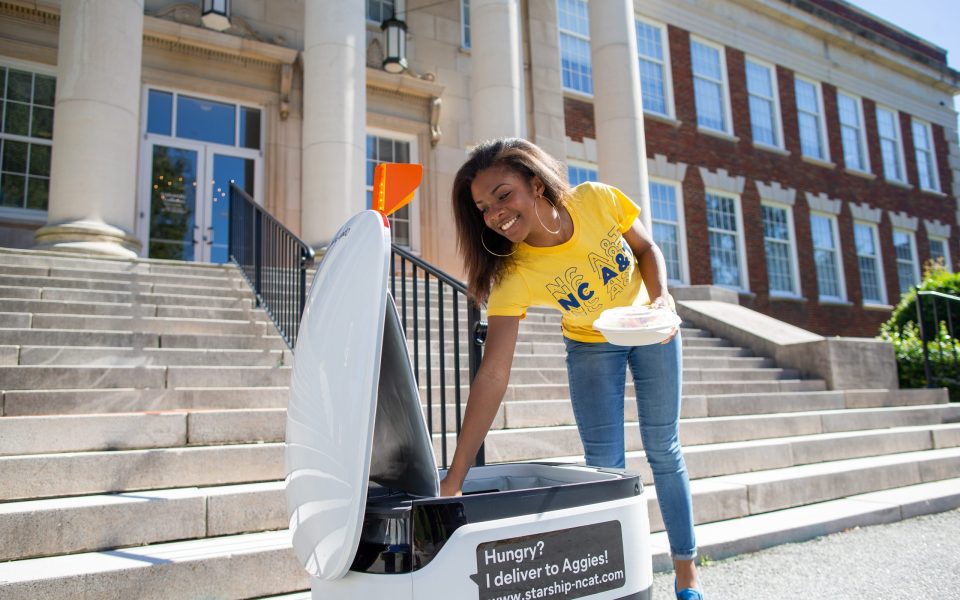Featured photo: NC A&T University is getting robots that bring food directly to students (courtesy photo)
Lined up together, NC A&T State University’s food robots look like something out of a sci-fi movie.
Rather than take over the world or assist on an interstellar voyage, these robots deliver food orders directly to A&T students, one at a time. Plus, they provide plenty of selfie opportunities for the enchanted students.
“Part of the name of our university is technology,” says Angela Peterson, associate vice chancellor of Campus Enterprises. “We have STEM as a major component of our university, so it was one of the ways of embracing that during the pandemic.”
The 20 robots, which arrived on campus earlier this school year, are built by Starship Technologies, a company that specifically develops small, self-driving delivery robots. The bots themselves are zero-emission and 99 percent autonomous once they have A&T’s map programmed into their system.
The robots use a combination of machine learning, AI and sensors to navigate their surroundings, which means they can cross streets or travel in bad weather, though a human can also take control if needed.
Students can order food using the Starship app from on-campus restaurants such as Qdoba, 1891 Bistro and Paavo’s Pizza. The robots bring the still-warm food to the customer and when everything is set, politely ask to be sent on their way.
The university is covering the fee for the robots for at least the first two years through HEERF, the Higher Education Emergency Relief Fund. But given the ability of the robots to deliver food in less than 20 minutes, A&T officials are looking beyond the pandemic as well.
“The students are loving it,” said Peterson. “They’re so excited.”
In addition to A&T, these robots have found homes in 16 states and across 20 college campuses. A&T is the first campus in North Carolina as well as the first HBCU to work with Starship. Orders are in from more campuses, and Sunitha Ravichandran, Starship Technology’s US launch specialist, expects to sell more quickly.
“We deliver food and groceries, but they’re developed to do book or prescription deliveries as well,” said Ravichandran. “With the pandemic, we really want to focus on contactless deliveries.”
Not everyone is impressed by the robots, however. Lissa Turner, an A&T alumnus who graduated from the university in 2018, wonders why the HEERF funds went into the robots rather than improving housing or providing scholarships.

Other institutions with HEERF funding are using it in a variety of ways. For example, the University of California Los Angeles, and the City University of New York have opted to expand their mental-health offerings to students according to their websites. Other schools such as the Ohio State University, the University of Missouri-St. Louis and Auburn University are using that money for student scholarships.
“For me, I feel like as a former student and someone who knows people who go to the school, I don’t mind the latest tech or the new student center, but can they worry about us first?” she asked. “Some of the stuff they do is for show and to show off for the investors.”
Still, others are excited about the robots, especially as a form of contactless delivery. Senior class Vice President Stacey Oxendine has not yet gotten a robot-delivered meal because she does not have a dining plan, but she does think they are a great way for students to get food during the pandemic.
Oxedine says the pandemic has made her wary of being around her fellow classmates, who may or may not be taking the same precautions she is. She gets a lot of her food from the bistro, which is located in the student center, a high-traffic area.
“It’s a place where everybody goes,” she says. “So just having the robots there to bring the food to you is great.”
It also keeps students from having to walk in the dark at night, she mentioned.
“It’s a great thing, and it’s something we haven’t seen,” says Oxedine. “I haven’t seen it on other campuses, and it’s honestly something that you can’t compete with.”
Join the First Amendment Society, a membership that goes directly to funding TCB‘s newsroom.
We believe that reporting can save the world.
The TCB First Amendment Society recognizes the vital role of a free, unfettered press with a bundling of local experiences designed to build community, and unique engagements with our newsroom that will help you understand, and shape, local journalism’s critical role in uplifting the people in our cities.
All revenue goes directly into the newsroom as reporters’ salaries and freelance commissions.


Leave a Reply